
Aesculus pavia, known as red buckeye or firecracker plant, is a species of deciduous flowering plant. The small tree or shrub is native to the southern and eastern parts of the United States, found from Illinois to Virginia in the north and from Texas to Florida in the south. It is hardy far to the north of its native range, with successful cultivation poleward to Arboretum Mustila in Finland.

Brugmansia is a genus of seven species of flowering plants in the nightshade family Solanaceae. They are woody trees or shrubs, with pendulous flowers, and have no spines on their fruit. Their large, fragrant flowers give them their common name of angel's trumpets, adjacent to the nickname devil's trumpets of the closely related genus Datura.
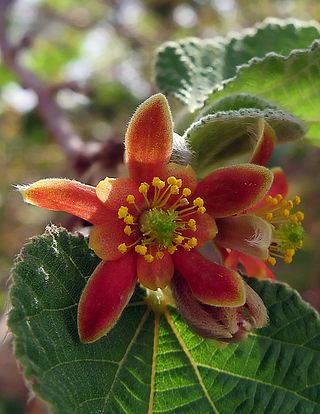
Grewia villosa is a shrub, often scrambling and hardly exceeding 4 m in height. Leaves are fairly large, serrated and heart-shaped. It grows naturally, mainly in dry habitats. It is common in most of the semi-arid parts of Eastern Africa but may now be rare in parts of its natural distribution. It can be seen in Ein Gedi oasis in Israel, and in South Africa, where it is common. Its ripe copper-coloured fruits are eaten in East Africa.
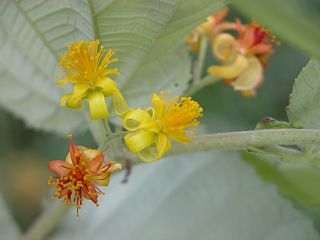
Grewia asiatica, commonly known as phalsa or falsa, is a species of flowering plant in the mallow family Malvaceae. It was first found in Varanasi, India, and was taken by Buddhist scholars to other Asian countries including Pakistan and the rest of the world. Grewia celtidifolia was initially considered a mere variety of phalsa, but is now recognized as a distinct species.
Grewia picta is a species of flowering plant in the family Malvaceae. It is found only in Seychelles. It is threatened by habitat loss.
Grewia turbinata is a species of flowering plant in the family Malvaceae sensu lato or Tiliaceae or Sparrmanniaceae. It is found only in Yemen. Its natural habitat is subtropical or tropical dry forests.

Leptospermum laevigatum, commonly known as the coast tea tree, is a species of shrub or small tree that is endemic to south-eastern Australia, but has been widely introduced in other places where it is often considered to be a weed. It has thin, rough bark on the older stems, narrow egg-shaped leaves, relatively large white flowers and flat topped fruit that is shed shortly after reaching maturity.

Myoporum insulare, commonly known as common boobialla, native juniper, is a species of flowering plant in the figwort family Scrophulariaceae and is endemic to coastal areas of Australia. It is a shrub or small tree which grows on dunes and coastal cliffs, is very salt tolerant and widely used in horticulture.
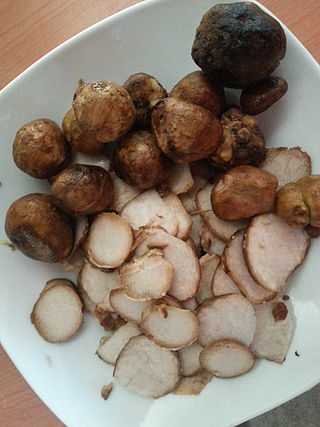
Kalaharituber is a fungal genus in the family Pezizaceae. It is a monotypic genus, whose single truffle-like species, Kalaharituber pfeilii, is found in the Kalahari Desert, which spans the larger part of Botswana, the east of Namibia and the Northern Cape Province of South Africa.

Grewia retusifolia is a shrub species in the family Malvaceae. Common names include dysentery bush, emu-berry, dog's balls, turkey bush and diddle diddle. It is widespread in tropical and subtropical areas of Eastern Australia and Northern Western Australia. The species produces small, sweet, two-lobed fruit with a fibrous acidic pulp surrounding the seeds. Leichhardt described the fruits as having a very agreeable taste, which could be boiled to make a refreshing drink. Indigenous Australians use the bark and leaves in medications. The crushed leaves were used as a poultice to relieve toothaches.
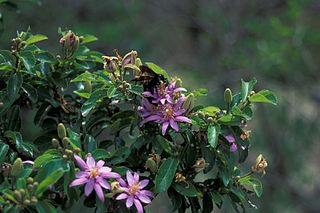
Grewia occidentalis, the crossberry, is a species of deciduous tree indigenous to Southern Africa.

Vachellia flava, synonym Acacia ehrenbergiana, is a species of drought-resistant bush or small tree, commonly known as salam in Arabic. It is found in the Sahara, the northern Sahel, parts of East Africa, the Arabian Peninsula and Iran.
Huberantha flava is a species of plant in the family Annonaceae. It is native to The Philippines. Elmer Drew Merrill the American botanist who first formally described the species, using the basionym Polyalthia flava, named it after its brilliant yellow flowers.
Grewia retinervis is a plant native to Namibia and South Africa. It is found in the North West and Limpopo provinces and is listed as "safe" (LC) by the SANBI Red List.
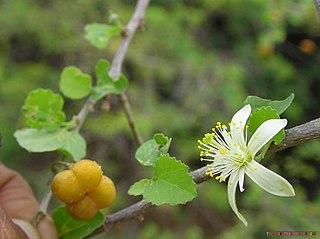
Grewia tenax, called the phalsa cherry, white crossberry, raisin bush, gangara, gangu, or kanger, is a species of flowering plant in the family Malvaceae. It is native to Africa, from the Sahara to Tanzania and parts of southern Africa, the Arabian Peninsula, and on to the Indian Subcontinent. The ripe fruit is edible and is consumed by local peoples either fresh, dried, or powered in drinks.
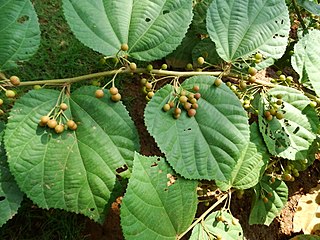
Grewia optiva, the bhimal, is a species of flowering plant in the family Malvaceae, native to the Indian Subcontinent.

Grewia flavescens, called rough-leaved raisin, sandpaper raisin, and donkey berry, is a species of flowering plant in the family Malvaceae, native to sub‑Saharan Africa, Yemen, Saudi Arabia, and India. It is considered to be an underutilized crop, both for its fruit and its use for livestock forage. Caterpillars of Anaphe reticulata have been found to feed on the foliage.

Grewia hexamita, the giant raisin, is a species of flowering plant in the family Malvaceae, native to Mozambique and adjoining countries. It is a large tree for a Grewia, reaching 5 m (16 ft). It is the most preferred woody plant of African savanna elephants, who browse on it in all seasons, unlike even other species of Grewia.
Grewia mollis is a widespread species of flowering plant in the family Malvaceae, native to tropical Africa, Yemen and Oman. It is the source of grewia gum, an edible polysaccharide mucilage, similar in its properties to tragacanth gum.

Grewia rogersii, the waterberg raisin is a species of plant in the family Malvaceae. It is generally considered a rare species as defined by the International Union for the Conservation of Nature and Natural Resources, but it can be abundant locally.





















